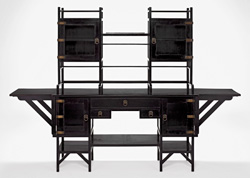In Britain and America, the Arts and Crafts movement coincided with the craze for all things Japanese, or Japanism, that was launched in 1854 when American Commodore Matthew Perry forced Japan to recommence international trade after over two centuries of virtual isolation. The Japanese objects that soon flooded the art market excited Westerners because of their sheer novelty.
Just as they sought to improve modern design by looking at previous styles such as the Gothic, Arts and Crafts practitioners embraced Japanese forms. They admired Japanese works because they, like medieval art, were thought to derive from a culture that was free from the depravities of modern industrialism. As designers grew more knowledgeable about Japanese art and culture they began emulating not merely the surface motifs they saw in the works, but their underlying design strategies. These principles—balance, geometry, modularity, and simplicity—are evident in British designer Edward William Godwin’s sideboard.
Westerners were also drawn to traditional Japanese artistic expression because of its ties to the natural world. Japanese artists in all media treated the subjects of birds, flowers, landscapes, and the seasons. These motifs were emulated by designers at American firms like Tiffany Studios, who used such flattened, abstracted natural forms in their stainedglass lamps and windows.
Edward William Godwin. Sideboard, c. 1876. Restricted gift of Robert Allerton, Harry and Maribel G. Blum, Mary and Leigh Block, Mary Waller Langhome, Mrs. Siegfried G. Schmidt, Tillie C. Cohn, Richard T. Crane, Jr. Memorial, Eugene A. Davidson, Harriott A. Fox, Florence L. Notter, Kay and Frederick Krehbiel, European Decorative Arts Purchase, and Irving and June Seaman endowments; through prior acquisition of the Reid Martin Estate.

